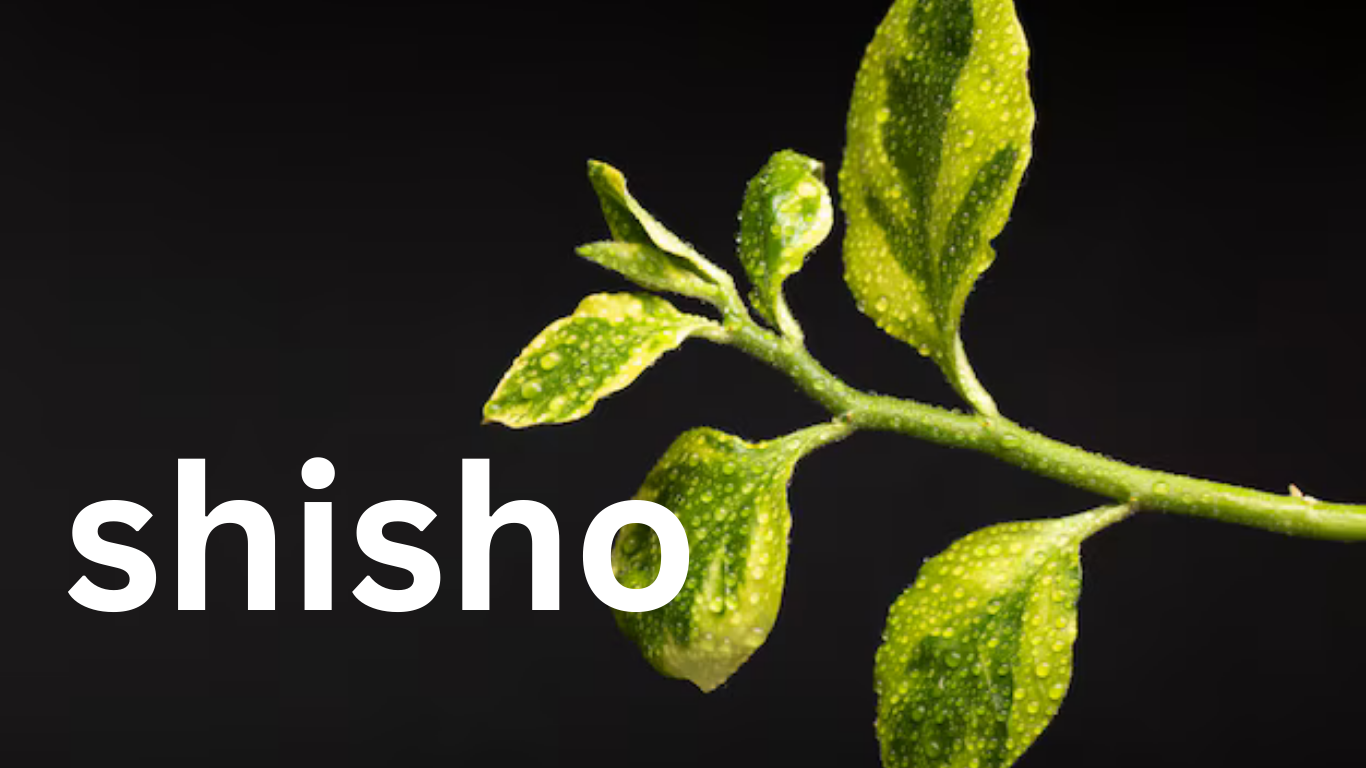EDUCATION
Shiso Leaves: A Versatile Herb in Culinary and Medicinal Use

Shiso (Perilla frutescens), also known as perilla or Japanese basil, is a fragrant herb widely used in Asian cuisine, particularly in Japan, Korea, and China. Shiso leaves are known for their unique flavor and numerous health benefits. This article explores the significance, varieties, uses, and health benefits of shiso leaves.
1. Introduction to Shiso Leaves
Shiso is a member of the mint family and offers an aromatic, slightly spicy, and tangy flavor profile. The leaves are often used to enhance the flavor of dishes or to add visual appeal.
2. Varieties of Shiso Leaves
Shiso comes in two main varieties, each offering distinct flavors and culinary applications:
- Green Shiso (Aojiso): Commonly used in sushi and sashimi as a garnish. It has a fresh, citrusy flavor with minty undertones.
- Red Shiso (Akajiso): More robust in flavor, red shiso is often used in pickling and to color dishes like umeboshi (Japanese pickled plums).
3. Culinary Uses of Shiso
Shiso leaves are highly versatile and can be used in various culinary traditions:
- Japanese Cuisine: Green shiso is used as a garnish for sashimi, added to salads, or served as a side dish with tempura.
- Korean Cuisine: In Korean dishes, shiso leaves are often used in wraps (ssam) or pickled for side dishes.
- Beverages and Condiments: Shiso can be used to flavor teas, sauces, and oils, adding depth to beverages and condiments.
4. Health Benefits of Shiso Leaves
Shiso leaves are rich in essential vitamins and minerals, making them a valuable addition to a healthy diet. Key health benefits include:
- Anti-inflammatory Properties: Shiso contains omega-3 fatty acids, which can reduce inflammation.
- Rich in Antioxidants: The leaves are high in flavonoids and rosmarinic acid, which help protect the body against oxidative stress.
- Support for Respiratory Health: Shiso is traditionally used in Asian medicine to help relieve asthma, coughs, and other respiratory ailments.
5. Medicinal and Traditional Uses of shisho leaves
Beyond their culinary applications, shiso leaves have long been used in traditional medicine for various purposes:
- Digestive Aid: Shiso is known to help alleviate indigestion and bloating.
- Allergy Relief: Shiso leaves are used in herbal remedies to treat allergic reactions, such as hay fever or skin rashes.
6. How to Grow Shiso Leaves
Shiso is easy to cultivate, making it accessible to gardeners and home cooks. It thrives in well-drained soil with partial sun, and the plant is often grown in herb gardens or containers.
7. Conclusion of shisho leaves
Shiso leaves offer a rich combination of flavor and health benefits, making them a valuable herb in both culinary and medicinal practices. Whether you are looking to enhance your dishes or explore natural remedies, shiso is a versatile herb with a lot to offer.
EDUCATION
Tutoring myths Exposed: What You Should Really Expect from Extra Help

When it comes to academic support, tutoring myths often gets a bad rap. Many people hold onto misconceptions about what tutoring really entails and who it’s for. It’s time to set the record straight! Whether you’re a parent considering extra help for your child or a student curious about how tutoring can fit into your study routine, understanding the reality behind common tutoring myths can open up new avenues for learning. So let’s dive in and uncover the truths that will change your perspective on this valuable resource!
Tutoring is only for struggling students
Many people believe that tutoring is solely for students who are having a tough time. This misconception overlooks the benefits that extra help can provide to learners of all levels.
High-achieving students often seek tutoring to deepen their understanding of subjects or prepare for advanced courses. They want an edge in competitive environments, and tutors can offer tailored strategies to enhance learning.
Even those with solid grades might find value in additional support, especially when tackling challenging material. A tutor can clarify complex concepts and boost confidence before exams.
In fact, tutoring serves as a great tool for skill sharpening rather than just remediation. It encourages personal growth and fosters a love for learning that transcends mere academic assistance.
Tutors are just hired to do homework for students
One common myth about tutoring is that tutors are merely there to complete homework assignments for students. This perception undermines the true value of what a tutor offers.
A good tutor aims to foster understanding and self-reliance in their students. Rather than just providing answers, they engage with learners to develop critical thinking skills. This approach encourages students to tackle problems independently in the future.
Tutors provide guidance on how to approach difficult concepts or challenging assignments. Their role is not about doing the work but rather empowering students to take ownership of their learning journey.
By promoting effective study habits and problem-solving strategies, tutors help build confidence. When students learn how to think through problems instead of relying on someone else, they become more equipped for academic success over time.
Tutoring is a one-size-fits-all solution
Many people believe that tutoring follows a one-size-fits-all approach. This misconception can lead students and parents to overlook the nuances of personalized learning.
Each student has unique strengths, weaknesses, and learning styles. A method that works for one might not resonate with another. Good tutors recognize this diversity and adapt their strategies accordingly.
Whether it’s hands-on activities, visual aids, or verbal explanations, effective tutors tailor lessons to meet individual needs. They assess progress regularly and modify plans as necessary.
Additionally, subjects vary widely in complexity. What helps a student excel in math may not suit someone struggling with literature analysis. Customized approaches ensure that each learner receives relevant support aligned with their goals.
In essence, successful tutoring is about creating a tailored experience rather than applying generic techniques across the board.
The Truth About Tutoring: What You Should Really Expect
When it comes to tutoring, many people have misconceptions. The reality is that tutoring can be a tailored experience designed to meet individual needs.
Expect personalized attention. A good tutor will assess your strengths and weaknesses, providing guidance specific to you. This isn’t just about rote memorization; it’s about understanding concepts deeply.
Communication plays a critical role as well. Tutors often encourage dialogue, asking questions that prompt students to think critically rather than simply delivering answers.
Moreover, the environment matters. A comfortable setting fosters better learning experiences. It’s not confined to traditional classrooms; online options make access easier than ever.
Remember that progress takes time. There won’t always be immediate results after one session. Embrace the journey of growth and learning throughout the process.
Benefits of Tutoring Beyond Academic Improvement
Tutoring offers a plethora of benefits that extend far beyond academic enhancement. One significant advantage is the boost in self-confidence students often experience. When they grasp concepts they once struggled with, their belief in their abilities flourishes.
Moreover, personalized tutoring fosters critical thinking skills. Tutors can tailor discussions and challenges to stimulate deeper understanding rather than rote memorization.
Beyond academics, these sessions help develop essential life skills such as time management and organization. Students learn how to prioritize tasks effectively through structured study sessions.
Additionally, having a dedicated mentor provides emotional support during stressful times. This relationship encourages open communication about struggles both academically and personally.
Exposure to different teaching styles broadens perspectives on learning itself. It empowers students to adapt strategies that work best for them throughout their educational journey.
How to Find the Right Tutor for Your Needs
Finding the right tutor can be a transformative experience. Start by identifying your specific needs. Are you looking for help in math, science, or language arts? Knowing this will guide your search.
Next, consider teaching styles. Some students thrive with structured approaches while others prefer more interactive methods. Reflect on what has worked best for you in the past.
Don’t forget to check qualifications and experience. A tutor with expertise in their subject area often brings valuable insights that can enhance learning.
It’s also important to assess compatibility. Try scheduling a trial session to see if the chemistry is there. Comfortable communication between student and tutor fosters better results.
Discuss availability and logistics upfront. Ensure that schedules align so consistent support is possible without interruption.
Conclusion:
Understanding the realities of tutoring can transform a student’s learning experience. Dispelling common tutoring myths empowers both parents and students to make informed decisions.
It’s essential to recognize that tutoring is not just for those who struggle academically. Many students seek tutors to enhance their skills or explore new subjects.
Moreover, effective tutors do much more than complete assignments; they foster understanding and build confidence in learners. Tailored sessions address individual needs rather than applying a one-size-fits-all approach.
Finding the right tutor can open doors for growth beyond grades, including personal development and critical thinking skills. The journey of learning becomes richer when approached with the right mindset.
FAQ’s
Is tutoring only for students struggling in school?
Not at all. While many seek extra help when they’re falling behind, tutoring can benefit students of all levels. Whether you want to excel or simply maintain your grades, a tutor can guide and challenge you.
Do tutors just do homework for their students?
No. Great tutors encourage independent thinking and problem-solving skills. They teach strategies that empower students rather than handing them answers on a silver platter.
Are all tutoring programs the same?
Definitely not! Each student has unique needs and learning styles. The most effective tutoring approaches are tailored specifically to each individual, enhancing their strengths while addressing areas that need improvement.
EDUCATION
Exploring the Life and Achievements of sofia d humphreys: A Rising Star

Sofia d humphreys is carving her name into the fabric of the entertainment industry. With a unique blend of talent, charisma, and unwavering determination, she’s quickly becoming a household name. Her journey from humble beginnings to stardom showcases not only her artistic abilities but also her passion for making a difference in the world. Fans are captivated by her performances, while others admire her relentless spirit off-screen. Join us as we delve into the life and achievements of this remarkable rising star who continues to inspire many with every step she takes in Hollywood and beyond.
Early Life and Education
Sofia D Humphreys was born in a vibrant city, where creativity thrived. From an early age, she demonstrated a passion for the arts. Her surroundings inspired her imagination and fueled her desire to perform.
Growing up, Sofia was encouraged by her family to explore various interests. She dabbled in dance, theater, and music. This diverse exposure shaped her artistic flair.
Education played a pivotal role in shaping Sofia’s career path. She attended prestigious schools known for their performing arts programs. Here, she honed her skills and developed confidence on stage.
Her dedication earned her recognition among peers and mentors alike. Teachers noted her unique talent early on, guiding her towards professional opportunities that awaited just around the corner.
With each passing year, it became clear that Sofia was destined for greatness within the entertainment landscape.
Career Accomplishments
Sofia D Humphreys has quickly made her mark in the entertainment landscape. Her early appearances showcased a talent that captivated audiences and critics alike.
She gained significant recognition for her role in an award-winning series, where her performance was both powerful and nuanced. This breakthrough opened doors to film projects, allowing Sofia to work alongside industry veterans.
Her versatility is impressive; she effortlessly transitions between drama, comedy, and even voice acting. Each new project demonstrates her commitment to growth as an artist.
Awards have also found their way to Sofia’s shelf. Nominations for prestigious honors reflect not just talent but hard work and dedication.
Behind the scenes, she contributes as a producer on several initiatives aimed at amplifying underrepresented voices in cinema. With each step forward, Sofia continues to redefine what it means to be a modern star in Hollywood’s dynamic environment.
Impact on the Entertainment Industry
Sofia D Humphreys has rapidly become a transformative figure in the entertainment industry. Her fresh perspective and innovative approach challenge traditional norms, paving the way for new narratives.
She embraces diversity both on-screen and off. This commitment resonates with audiences seeking authentic representation. By championing underrepresented voices, she enriches storytelling in ways that feel genuine and relatable.
Her collaborations span genres, blending elements of drama, comedy, and social commentary. Each project reflects her dedication to pushing boundaries while entertaining viewers.
Moreover, Sofia actively engages with her fan base through social media platforms. This connection fosters a community that celebrates creativity and inclusivity.
As she continues to rise within Hollywood’s ranks, it’s clear her influence extends beyond acting alone. Her willingness to advocate for change inspires others in the industry to follow suit.
Philanthropy and Activism
Sofia D Humphreys is not just about her on-screen presence. Her heart lies deeply in philanthropy and activism. She has consistently used her platform to champion causes close to her.
From environmental issues to social justice, Sofia’s efforts resonate with many. She actively participates in campaigns aimed at combating climate change, believing that everyone has a role to play.
Sofia also supports various charities focused on education and mental health. Her initiatives often involve fundraising events where she engages fans and fellow artists alike.
Beyond donations, she encourages dialogue around important topics through social media. This creates awareness and fosters community engagement.
With each project, Sofia D Humphreys demonstrates the power of influence for good. Her commitment inspires others to take action within their own communities.
Future Projects and Endeavors
Sofia D Humphreys is on the brink of some exciting new ventures. With her unique talent, she continues to push boundaries in the entertainment industry.
Fans can expect her next big project—a film that not only captivates but also inspires audiences. This upcoming role showcases her incredible range as an actress and highlights deeper societal themes.
Beyond acting, Sofia is venturing into production. She aims to create content that resonates with diverse voices and underrepresented stories. Her commitment to authentic storytelling sets a new standard for aspiring filmmakers.
Additionally, Sofia has hinted at collaborations with well-known artists across various platforms including music and digital media. These projects promise fresh perspectives and innovative approaches.
Each endeavor reflects her passion for creativity and social change, solidifying her status as a true rising star in Hollywood’s landscape.
Conclusion:
Sofia D Humphreys continues to carve her name into the fabric of modern culture. Her journey is a testament to passion and dedication. Each step forward showcases her commitment to excellence.
Fans eagerly anticipate what she will do next. The blend of talent and charisma makes Sofia a captivating figure in entertainment.
She inspires many, proving that hard work pays off in ways we often can’t predict. As she embraces new opportunities, her influence expands beyond the screen.
FAQ’s
What are some notable works by Sofia D Humphreys?
Sofia has starred in several acclaimed films and television series. Her versatility as an actress shines through in each role she undertakes.
How did Sofia D Humphreys get started in acting?
Her passion for acting began at a young age. She participated in local theater productions before moving on to more significant roles.
Is Sofia involved in any charitable organizations?
Yes, Sofia is known for her philanthropic work. She actively supports various charities focused on education and youth empowerment.

